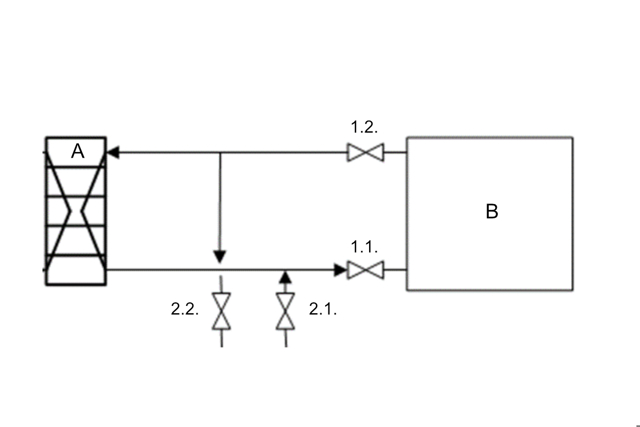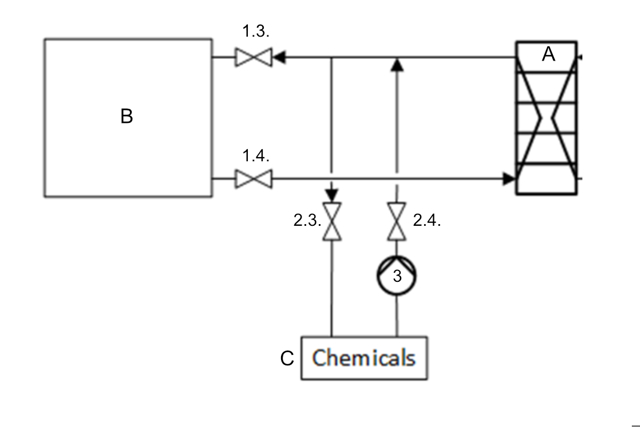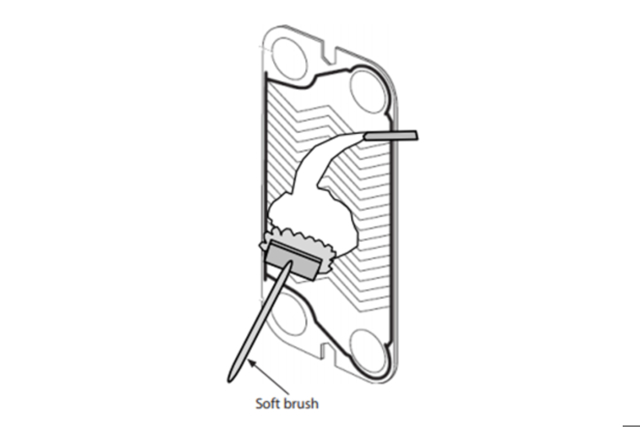Semi-welded plate heat exchanger services
The correct operation and timely qualified aftersales service of the heat exchangers ensures efficient operation of the whole industrial refrigeration system.
Danfoss provides required professional warranty and post-guarantee service support for all supplied heat exchangers through an official network of dedicated service partners.
The official service partners have been granted the authority to carry out a wide range of activities for heat exchangers such as:
- Audit and performance diagnostics of heat exchangers
- Shutting down, opening and starting up of heat exchangers
- Warranty and post-guarantee service using genuine spare parts
- Extension of heat exchangers
- Cleaning of heat exchangers
- Pressure and leak testing
Cleaning methods
The rules and requirements for cleaning a heat exchanger vary from type to type. If there is a risk of fouling, the unit should be monitored by measuring its working parameters. When losses are greater than permitted, the heat exchanger should be cleaned.
Spare parts
The genuine Danfoss spare parts are manufactured from high quality compounds on special equipment to deliver functionality, reliability and safety for Danfoss heat exchangers.
The genuine spare parts are available worldwide through official Danfoss partners.
Training
When you use Danfoss heat exchanger, you use highly reliable products. Our team is experienced Industrial Refrigeration experts and always ready to share knowledge.
Please contact us if you are service company and interested in training for Danfoss Heat Exchangers in Industrial Refrigeration applications.
Documents
| Type | Name | Language | Valid for | Updated | Download | File type |
|---|---|---|---|---|---|---|
| User guide | Plate Type Heat Exchangers, Single plate and Semi-welded Installation, Commissioning and Maintenance | Italian | Multiple | 23 Jul, 2019 | 6.2 MB | |
| User guide | Plate Type Heat Exchangers, Single plate and Semi-welded Installation, Commissioning and Maintenance | Russian | Multiple | 23 Jul, 2019 | 6.2 MB | |
| User guide | Plate Type Heat Exchangers, Single plate and Semi-welded Installation, Commissioning and Maintenance | German | Multiple | 23 Jul, 2019 | 6.2 MB | |
| User guide | Plate Type Heat Exchangers, Single plate and Semi-welded Installation, Commissioning and Maintenance | English | Multiple | 23 Jul, 2019 | 6.2 MB | |
| User guide | Plate Type Heat Exchangers, Single plate and Semi-welded Installation, Commissioning and Maintenance | Portuguese | Multiple | 23 Jul, 2019 | 6.2 MB | |
| User guide | Plate Type Heat Exchangers, Single plate and Semi-welded Installation, Commissioning and Maintenance | Danish | Multiple | 23 Jul, 2019 | 6.2 MB | |
| User guide | Plate Type Heat Exchangers, Single plate and Semi-welded Installation, Commissioning and Maintenance | French | Multiple | 23 Jul, 2019 | 6.2 MB | |
| User guide | Plate Type Heat Exchangers, Single plate and Semi-welded Installation, Commissioning and Maintenance | Chinese (CN) | Multiple | 23 Jul, 2019 | 6.7 MB | |
| User guide | Plate Type Heat Exchangers, Single plate and Semi-welded Installation, Commissioning and Maintenance | Polish | Multiple | 23 Jul, 2019 | 6.2 MB | |
| User guide | Plate Type Heat Exchangers, Single plate and Semi-welded Installation, Commissioning and Maintenance | Spanish, Castilian | Multiple | 23 Jul, 2019 | 6.2 MB |
Contact us
Contact our regional heat exchanger experts in Industrial Refrigeration applications for further support:
| Region | Country | PHE expert | |
|
Europe |
Sweden | Johan Rissler | Johan.Rissler@danfoss.com |
| Norway | Johan Rissler | Johan.Rissler@danfoss.com | |
| Denmark | Johan Rissler | Johan.Rissler@danfoss.com | |
| UK | Johan Rissler | Johan.Rissler@danfoss.com | |
| Finland | Johan Rissler | Johan.Rissler@danfoss.com | |
| Baltics | Johan Rissler | Johan.Rissler@danfoss.com | |
| Italy | Tommaso Giorgetti | tommaso.giorgetti@danfoss.com | |
| France | Joaquim Edo | joaquim.edo@danfoss.com | |
| Spain | Cristina Martin-Borregon | cristina.martinborregon@danfoss.com | |
| Netherlands | Arman Mansouri | arman.mansouri@danfoss.com | |
| Belgium | Bruno Yperman | bruno.yperman@danfoss.com | |
| Germany | Alexander Käs-Schlinkheider | Alexander.Kaes-Schlinkheider@danfoss.com | |
| Poland |
Leonid Tykhomirov Mikolaj Klinkiewicz |
||
| Czech | Jakub Horky | jakub.horky@danfoss.com | |
| Slovakia | Jakub Horky | jakub.horky@danfoss.com | |
| Hungary | Csaba Fribert | csaba.fribert@danfoss.com | |
| Romania | Romulus Papuc | Romulus.Papuc@danfoss.com | |
| Bulgaria | Romulus Papuc | Romulus.Papuc@danfoss.com | |
| Serbia | Vladimir Beljanski | vladimir.beljanski@danfoss.com | |
| Ukraine | Tykhomirov Leonid | leon@danfoss.com | |
| China | China | Zhihua (Alfred)Huang | HuangZhihua@danfoss.com |
|
Asia Pacific |
Australia | Alan Kelly | kelly_a@danfoss.com |
| Korea | Ji Hoon(Adam) Park | jhpark@danfoss.com | |
| Vietnam | Duc Tu (Kevin) Tran | tu.tran@danfoss.com | |
| Thailand | Pattarapon (Jack) Maneesri | pattarapon.maneesri@danfoss.com | |
| Indonesia | Khodrat Desta Novanto | desta@danfoss.com | |
| Phillipines | Edgar Escobar | eescobar@danfoss.com | |
| North America | USA/Canada | Daniel Swann | danswann@danfoss.com |
| India | India | Mahesh More | mahesh.more@danfoss.com |
|
Latin America |
Mexico | Roberto Badillo Chavez | r.badillo@danfoss.com |
| Chile/Peru | Sergio David Salinas Ulloa | sulloa@danfoss.com | |
| Columbia | Rafael David Canache Campos | rafael.canache@danfoss.com | |
| Brazil | Edna de Menezes Tavares | ednamt@danfoss.com | |
| Argentina | Jose Alberto Montagano | montagano@danfoss.com | |
|
Middle East |
Turkey | Baris Kurt | baris.kurt@danfoss.com |
| South Arica | Brett Aarons | aaronsb@danfoss.com | |
|
Middle East |
Suresh N. Sharma | suresh.sn@danfoss.com | |
| Dhanraj Katte | dhanraj.katte@danfoss.com |






